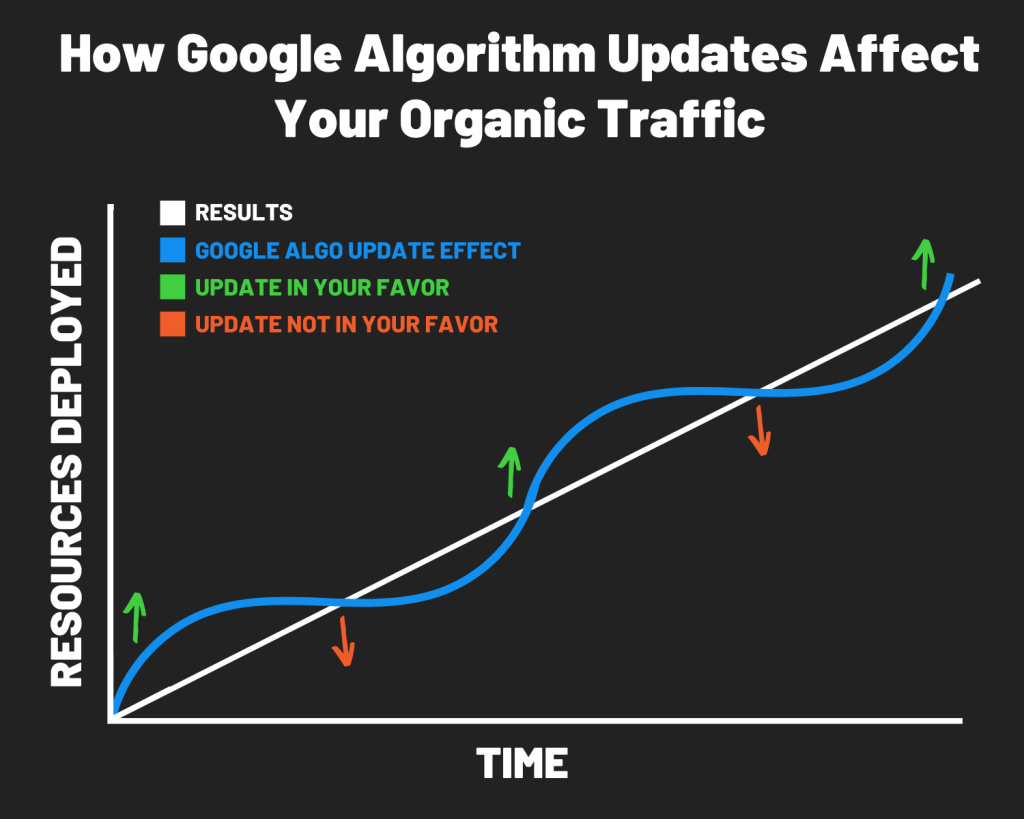At some point, Google will hit your site. One day, you’ll wake up and realize both your keyword rankings and organic traffic have been pulled down by a Google core algorithm update.
Algorithm updates aren’t always a bad thing. Some will be in your favor, but it’s just a matter of time before one isn’t. When that day comes, you’ll want to be prepared.
What Is a Core Algorithm Update?
The content that appears on the first page of Google is determined by Google’s search algorithm. Its parameters update when Google shifts the weighting of its ~200 ranking factors.
We don’t get to know all ~200 of them, but here are a few key factors we do know:
- EEAT, or expertise, experience, authoritativeness, and trustworthiness — all characteristics Google looks for to determine what content gets a spot on the first page when someone searches for something.
- Backlinks. Every time another site links to yours, Google sees that as an unbiased, third-party vote of confidence in the quality and legitimacy of your website and brand. As far as the algorithm is concerned, more links = more authority.
- On-page optimization. Your pages and content must be structured to make the topic easy to understand for both humans and search engines.
Google also checks how many people click through from their search engine results pages (SERPs). It then measures how long people stick around on the web pages they click to from Google’s results.
If a user searches for a keyword, clicks to a result and then spends a lot of time reading that page before ending their search, the content must satisfy a search for that keyword. Google uses that data to determine whether a web page deserves a spot on its first page of results.
If a page’s user data is better than its previous batch (i.e. more clicks, more time spent on the page, less time going back to the search engine to check other results), then that URL earns a place on Page #1. And all this data informs future algorithm updates.
This isn’t the result of malicious intent on Google’s part. In fact, far from it. Google’s goal is to provide people with the best results possible, period.
That’s why the best way to make your site algorithm update-resistant is to create the best content possible. Users will be happy with the product, service or information you give them when they search for related keywords, and Google will take note.
There are other types of updates, such as reviews updates, which only affect review-based content. Other updates affect only medical sites, and still others focus on spam removal. Core updates, which we just discussed, are more general and broad-sweeping.
How Do These Updates Affect Your Site?
If an update is in your favor, your keywords and rankings will go up, generating more leads and sales.
If an update isn’t in your favor, in the short term, you’ll lose keywords, and therefore traffic, and therefore leads and sales.
Ecommerce businesses are particularly vulnerable to algorithm updates, so it can be a good idea to manage cash flow with that in mind. For example, spending all your profits on as much stock as you can afford with the expectation that sales generated by traffic from Google will continue to increase indefinitely can backfire.
Instead, while the profits are rolling in and organic traffic is growing, allocate a six-month emergency fund for expenses. That way, when an algorithm update does hit, you’ll be ready.

What Should You Do When the Algorithm Updates?
In Your Favor
When an algorithm update is in your favor, kick back and enjoy the traffic boons. It’s best not to mess with something that’s working, so keep doing what you’re doing. If it ain’t broke, don’t fix it!
See the above point on setting money aside for marketing and other expenses while you’re doing well.
Not in Your Favor
There are two things to do when an algorithm update isn’t in your favor.
- Continue doing what you’ve been doing. A consistent publishing schedule of high-quality content is the best thing you can do to gain keyword rankings and organic traffic that generates leads and sales. Changing the publishing schedule will drastically reduce your chances of recovery.
- Fix any problems with your site. When a campaign is posting significant traffic gains each month, it’s best to leave it alone, because Google doesn’t like seeing changes to site structure. But when an algorithm update breaks your upward trend, it’s a good time to review your site structure and content strategy for areas of improvement.
How Long Does It Take to Recover?
How long does it take to recover from an algorithm update?
Often, it takes until the next core algorithm update, or the one after that. They usually roll out several times a year, so the answer is often a few months.
However, because there are so many variables, the more you learn about SEO, the more likely you are to answer SEO questions with “it depends.” That’s especially true in this case. Here are a few factors that play into recovery time:
- Have you stuck to your publishing schedule? Did you address any site issues?
- To what extent are your competitors investing in SEO? If it’s more than you, they may be able to outrank you if they have a strategy that’s at least as good as yours.
- Sometimes an algorithm update will revert itself within a few short weeks if Google determines the new results on Page #1 perform worse than the previous set. At that point, you’ll get your rankings back.

Google Core Algorithm Updates: Final Thoughts
A lot remains unknown about Google’s core algorithm and the hundreds of factors it uses to rank pages, even by Google employees themselves.
Don’t let that scare you. If you’re working with a team that has a proven track record of strong SEO results, trust in your content strategy and continue to deploy resources into it. When the algorithm updates again, you’ll be glad you did.



